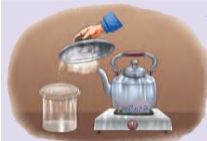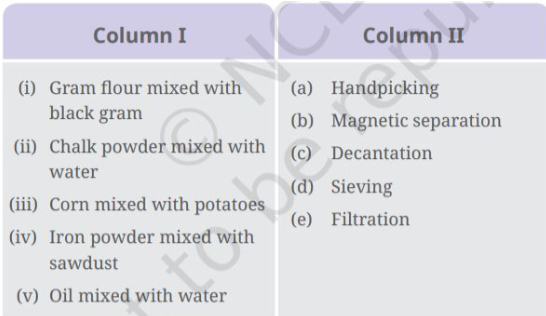NCERT Solutions for Ch 9 Methods of Separation in Everyday Life Class 6 Science
Book Solutions1
Answer
The mixture of rice with chana dal can be separated by sieving or by using soop(bamboo tray) other than handpicking.2
Answer
Valli can use a fan to separate husk from rice.3
Answer
Yes, I have observed using large sieve to separate pebbles and stones from the sand.4
Answer
The white patches formed on the dark coloured clothes during summer are formed due to evaporation of sweat due to heat leaving behind salts on the clothes.5

Answer
Yes, it answers the question. The process involved in the above picture is condensation.6
Answer
The process we use to separate oil and water is decantation. In this process, the water (liquid) is removed by tilting the vessel.7
(i) Filtration
(ii) Sorting
(iii) Evaporation
(iv) Decantation
Answer
(ii) Sorting8
(i) Oil from water
(ii) Sand from water
(iii) Cream from milk
(iv) Oxygen from air
Answer
(iii) Cream from milk9
(i) Apparatus size
(ii) Presence of air
(iii) Pore size
(iv) Temperature of the mixture
Answer
(iii) Pore size10
(i) Salt can be separated from salt solution by keeping it under the Sun. [ ]
(ii) Handpicking should be used only when the quantity of one component is less. [ ]
(iii) A mixture of puffed rice and rice grains can be separated by threshing. [ ]
(iv) A mixture of mustard oil and lemon water can be separated by decantation. [ ]
(v) Sieving is used to separate a mixture of rice flour and water. [ ]
Answer
(i) Salt can be separated from salt solution by keeping it under the Sun. True [T](ii) Handpicking should be used only when the quantity of one component is less. True [T]
(iii) A mixture of puffed rice and rice grains can be separated by threshing. False [F]
Correct Statement: A mixture of puffed rice and rice can be separated by winnowing as puffed rice is lighter than rice grain.
(iv) A mixture of mustard oil and lemon water can be separated by decantation. True [T]
(v) Sieving is used to separate a mixture of rice flour and water. False [F]
Correct Statement: To separate rice flour and water, evaporation or filtration is used.
11

Answer

12
Answer
Decantation method can be used other than filtration to separate solids from liquids. This method is used when the solid particles are heavy and settle down at the bottom of the container. It allows the clear liquid to be poured off without disturbing the solid sediment.For example separating sand from water.
13
Answer
Yes, the presence of nasal hair can be compared to the process of filtration. Filtration removes unwanted impurities from liquids and gases. Similarly, nasal hair filters out dust particles, pollen, and other foreign particles from the air we breathe. This prevents them from entering the respiratory tract.14
Answer
Masks are generally made of cotton fabric, polyester, and polypropylene. They not only prevent dust particles present in the air from entering the nasal cavity but also act as a barrier, blocking bacteria, viruses, and other pathogens.15
Answer
Stepwise procedure for separating each component:i. Separate the potatoes from the mixture by handpicking.
ii. Add water to the remaining mixture of salt and sawdust, which will dissolve the salt.
iii. Filter the sawdust from the salt solution using filter paper.
iv. Evaporate the water from the salt solution to obtain the salt.
16
Water /grains. After obtaining some water in the container, she noticed that the water was muddy and fit/unfit for drinking. To purify the water, she kept it for some time and then she filtered/churned the muddy water using a piece of paper/muslin cloth. Leela, then,cooled/boiled the water for about 10 minutes in a covered pan. After cooling/boiling, she filtered/churned it again and made it fit/unfit for drinking. She served this water to her fatherwhile having food, who blessed her and appreciated her efforts.
Answer
Title: Leela purify water for her father
Leela was working in the farm with her father when she realised that they left their drinking water at home. Before her father felt thirsty, she went to the nearby pond to fetch some water. After obtaining some water in the container, she noticed that the water was muddy and unfit for drinking. To purify the water, she kept it for some time and then she filtered the muddy water using a piece of paper/muslin cloth. Leela, then, boiled the water for about 10 minutes in a covered pan. After cooling, she filtered it again and made it fit for drinking. She served this water to her father while having food, who blessed her and appreciated her efforts.